
15-17 October 2015. Once there was an island in the mighty Nile River, a little south of what is now the city of Aswan. It was called Philae in Greek, or Pilak in ancient Egyptian, meaning ‘the end’. The island defined the end, or the ancient southern boundary, of Egypt.
Once there were three Egyptian gods whose magical and bloody story rivals Shakespeare’s tragedies. These three gods dominated ancient Egyptian culture and were known as Isis, Osiris, and Horus. But there’s no story without a villain. Enter Seth, Osiris’ brother. Because he wanted to be king, and because he was jealous, Seth murdered Osiris, then chopped his body into pieces and scattered them far and wide. The goddess Isis, being madly powerful, and smart as well as magical, managed to find all the parts of Osiris’ body and brought him back to life. Isis and Osiris, who, by the way, was her brother, then conceived their son Horus.
Osiris became god of the underworld and all who died answered to him. He was the ancient Egyptian equivalent of Judgment Day. When he was grown Horus tracked down and killed Seth in combat to avenge his father. Isis was associated with funeral rites, but she was also worshipped as an enchantress, as the giver of life, as a healer, and as the protector of Kings. This myth goes back to the very beginning of ancient Egypt and is perhaps five thousand years old.
Once there was a goddess named Isis, known as the ‘Mother of God’ and depicted with a throne on her head. She was so revered that by the seventh century BCE a cult devoted to her arose on the island at the end of Egypt. A temple was built in her honour. Over the centuries her cult spread throughout Greece, the Roman Empire, and as far away as London. Pilgrims came from all over the ancient world to worship at her temple on Philae. With time the building was expanded to become the great Temple of Isis, which sits to this day on an island in the middle of the Nile. For nearly one thousand years, as the heart of the cult of the invincible goddess Isis, Philae was the spiritual centre of the universe. Finally Roman Emperor Justinian closed down the temple in 535 CE some two hundred years after Rome had converted to Christianity.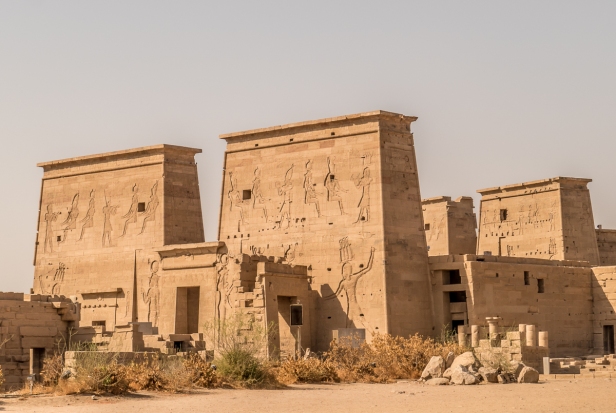
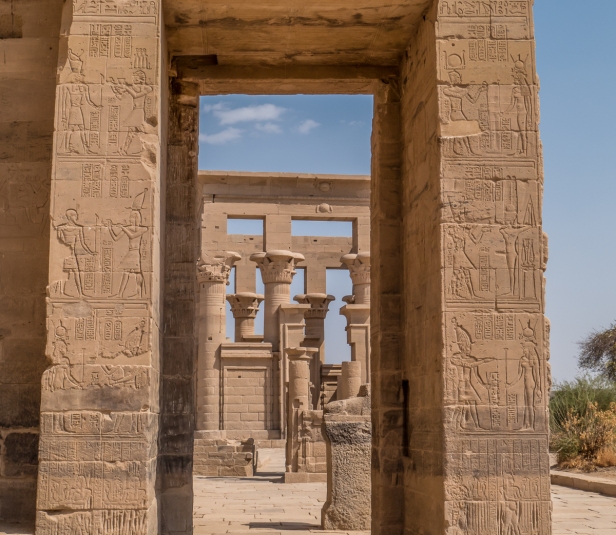
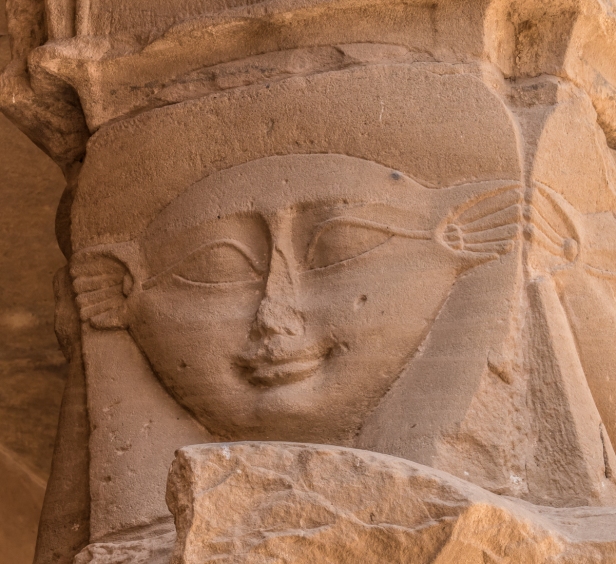
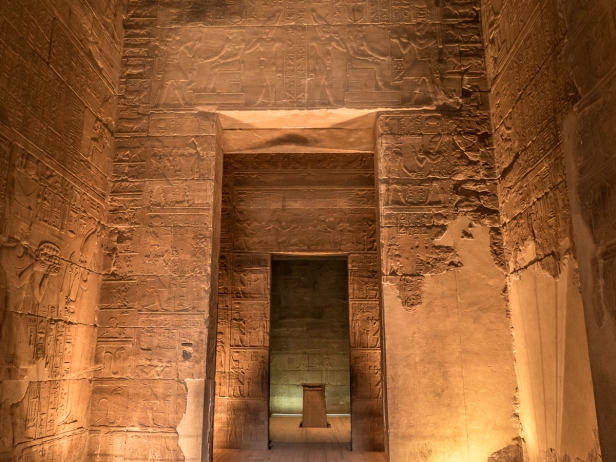
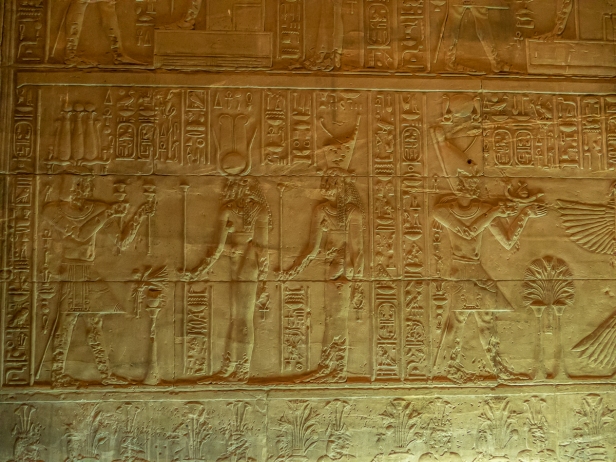
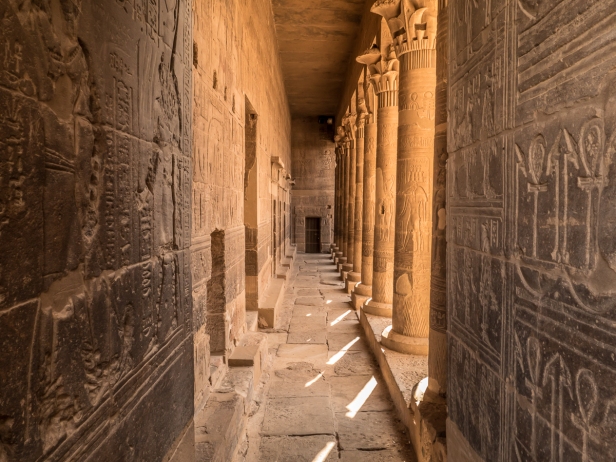
We see an imposing but sombre building of warm ochre stone, but the building that the people of antiquity saw was brightly coloured, painted in detail in brilliant reds, yellows, blues and greens. It would have been exquisitely beautiful, and likely inspired great reverence and devotion. And joy. I can’t imagine being in such a colourful place, created in love, and not feeling joy. In its original splendour it would no doubt have rivalled the glorious cathedrals and mosques of later centuries.
Once there was an island in the mighty Nile River known as Philae that was completely submerged in the waters of Lake Nasser with the building of the great Aswan High Dam. In a heroic joint operation between the Egyptian government and UNESCO the Temple of Isis was dismantled piece by piece. All 43,000 pieces were carefully labeled. On the nearby island of Agilkia the terrain was landscaped to mimic that of Philae and there the temple was reconstructed like a giant jigsaw puzzle. A project that took ten years saved one of Egypt’s most iconic temples.
About 850 kilometres (530 miles) south of Cairo, on the east bank of the Nile is the city of Aswan. It was the first Egyptian town, a frontier town, and the ancient commercial boundary of Egypt. Facing north from Aswan it is possible to travel on the Nile without obstruction all the way to the delta, to the Mediterranean Sea. Facing south the cataracts begin and the Nile becomes difficult to navigate. In the past Aswan was a garrison town in campaigns against the Nubians who lived south of the First Cataract, as well as a prosperous commercial centre at the crossroads of ancient caravan routes. It’s ancient name of Swen, or Swenett, means market.
Today Aswan is quiet and laid back when compared to Cairo. Colourful Nubian villages climb up the banks above the water,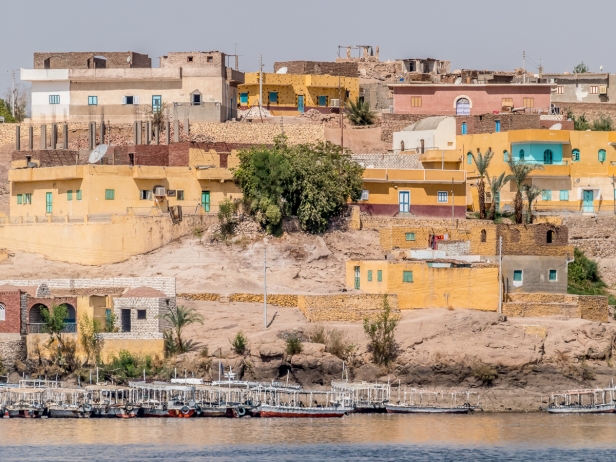
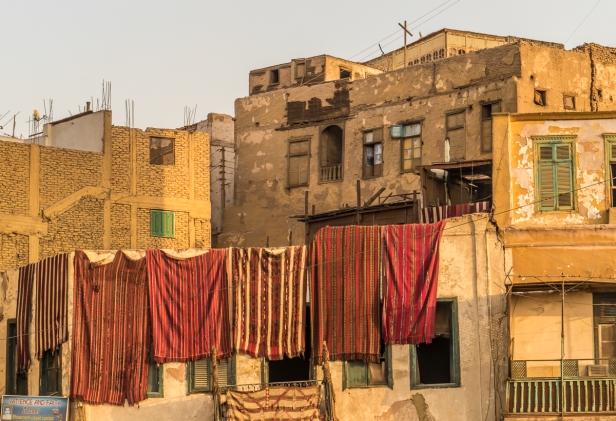
and boys play like otters in the wide deep river.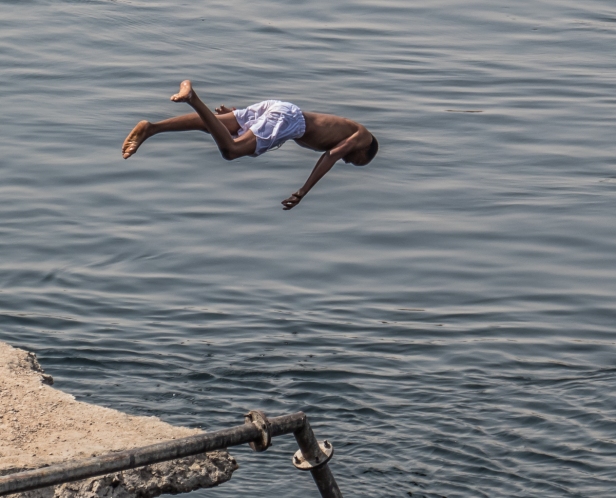
Eager to welcome us, others, on their way to school, wave smiling from the back of a truck.
We arrive in Aswan by train in the early morning and stay for nearly three days. Wandering the streets at various times we discover the broad corniche by the river,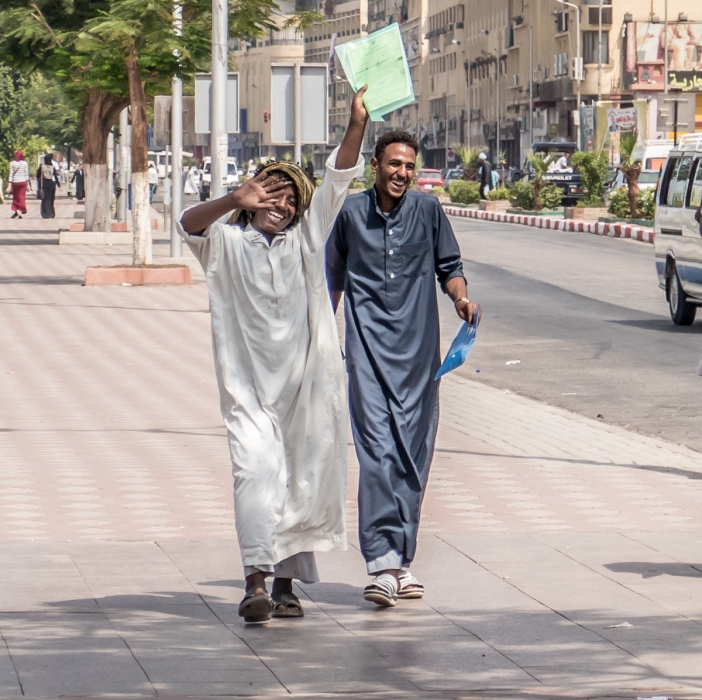
and ragged back alleys.
People catch my eye, adults and children living their lives in a way that is ordinary for them but to me mysterious and exotic.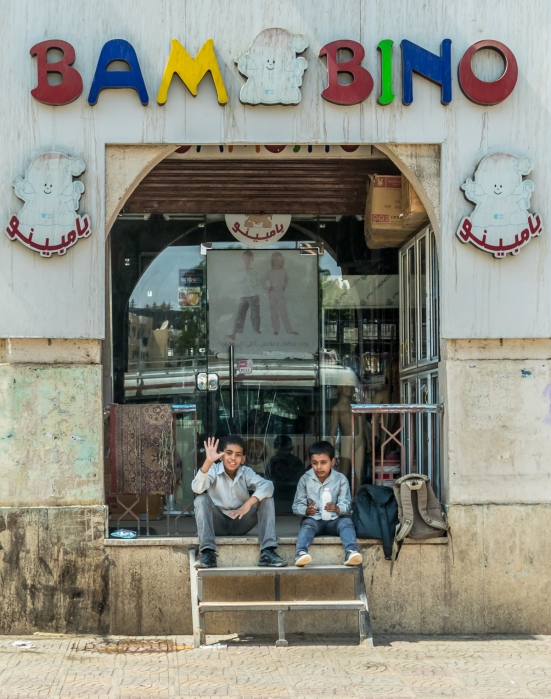

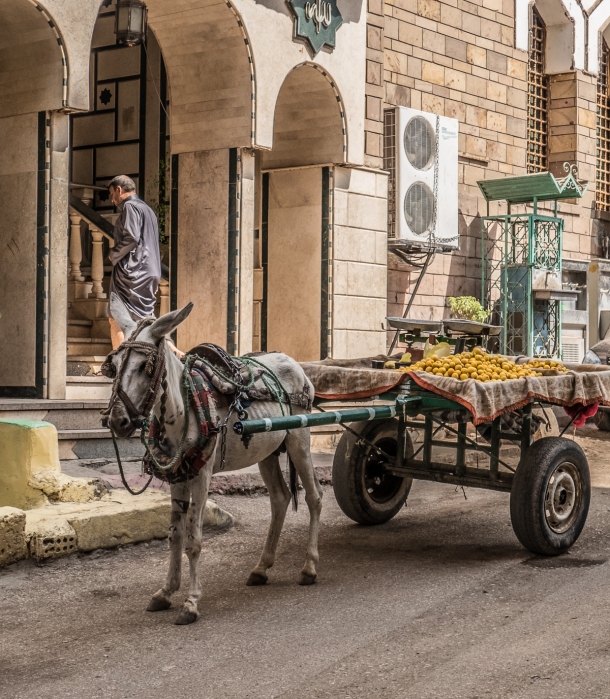
Left to our own devices one afternoon we discover the souk with its crowded display of goods for sale: baskets and shawls, jewellery and lingerie, scarves, vegetables, galabeyas and western clothing, and the potent scent of incense, spices, and perfumes.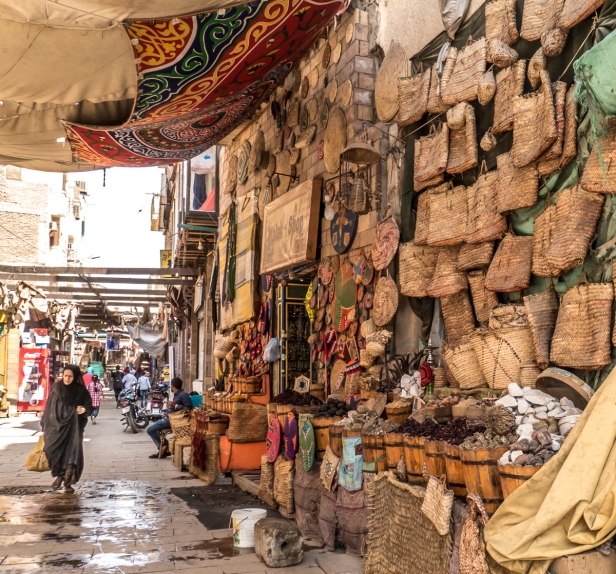


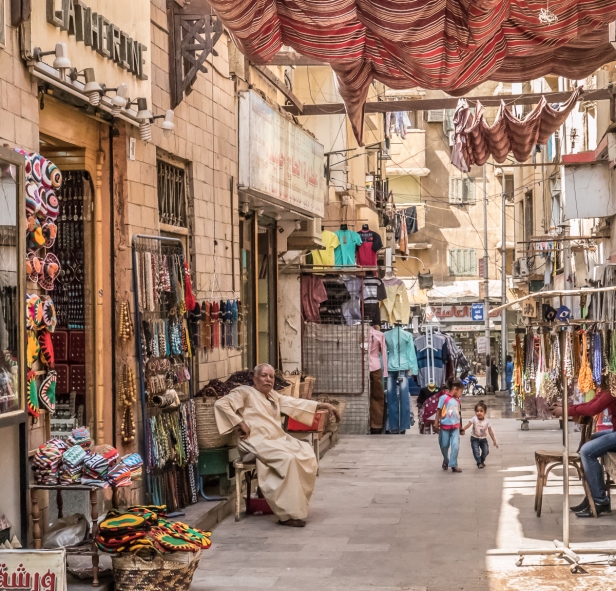
And then we see the bread boy delivering great trays of bread from this rack: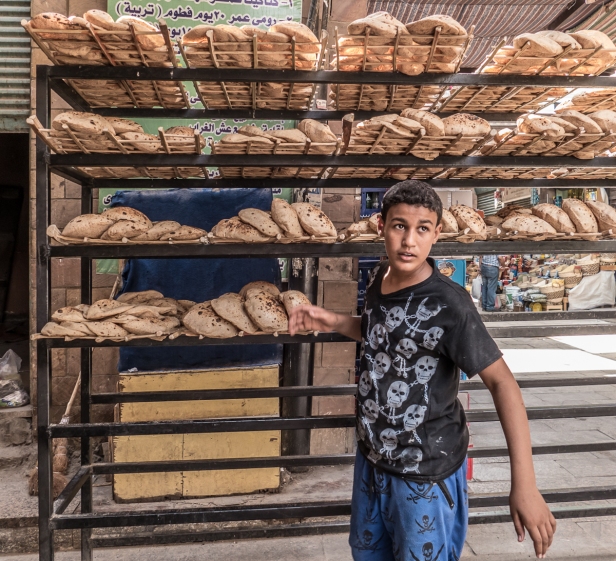
We are invited into the bakery. What a production! Each man has his job – mixing the dough, forming the mounds of dough and filling the wooden trays, moving the trays to the pile beside the oven, flattening the dough balls and slinging them into the oven, and collecting the hot fresh aromatic loaves when they are cooked. Laughter and cigarettes flow freely. It wouldn’t have surprised me to find specks of grey cigarette ash in my bread at dinner, though I never did. Not that I looked. Sometimes it’s better not to know.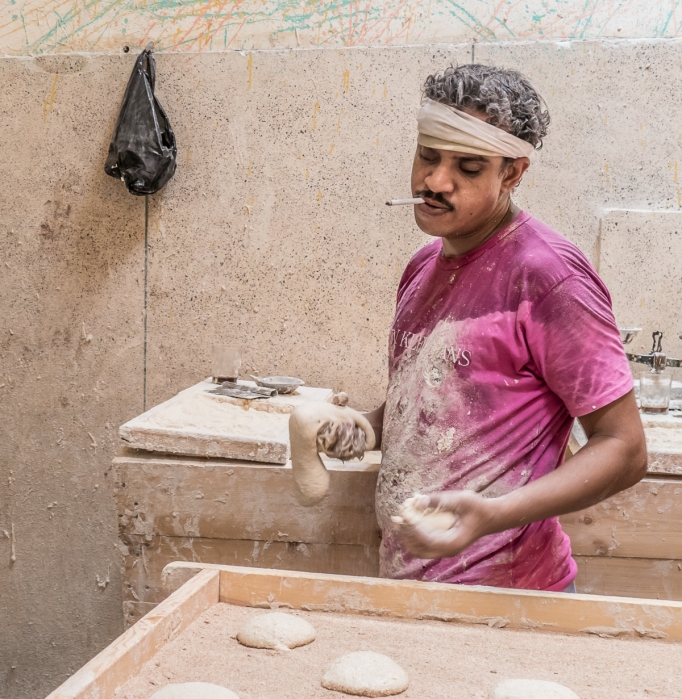
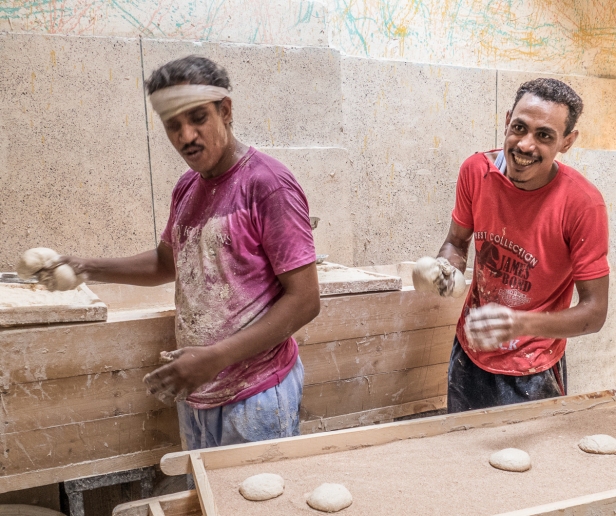

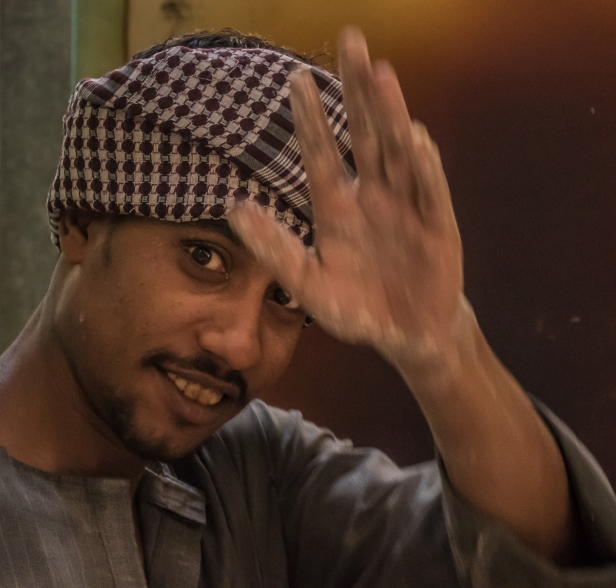
The river here at Aswan is lazy and wide, its beautiful blue waters caught between ochre sand, and islands green with the gently swaying leaves of palms and other tropical plants. 
We spend a lot of time on the water. We travel by boat to Philae Island, we travel by boat to have dinner in a Nubian village upstream, and we travel by traditional felucca upstream to the Old Cataract Hotel where Agatha Christie wrote Death on the Nile. All that and more in the next post.
All words and images by Alison Louise Armstrong unless otherwise noted
© Alison Louise Armstrong and Adventures in Wonderland – a pilgrimage of the heart, 2010-2016.

So jealous – I would love to cruise these waters. On the list! I love your photos, they bring the blog alive.
LikeLiked by 1 person
Thanks Anne. It was a life long dream for me and getting to do it was beyond wonderful. As well as the shorter river trips we also did a 3 night cruise from Aswan to Luxor which was definitely a peak experience. Hope you get there! Egypt is extraordinary.
Alison
LikeLike
Absolutely wonderful as always. Thank you so much.
LikeLiked by 1 person
Thanks Ros, I’m so glad you’re enjoying the blog!
Alison
LikeLike
Fascinating vignettes of Aswan and temple of Isis, places and structures in Egypt that I have not seen, as with my brief tenure there, I could only catch up with sights in Alexandria, Cairo, Port Said and a Nile cruise. There are plenty of sights more in Egypt, as amply brought out in your narrative. Thanks Alison and Don. Be well, and best wishes with your travels…
LikeLiked by 1 person
Thanks so much Rajagopal. It sounds as if you still saw quite a lot of Egypt, but you are right, there is so much to see there that it would take a long time to see it all. It’s a really extraordinary country. We feel privileged to have seen as much as we did.
Alison
LikeLike
Alison this brings back many memories for me because my husband and I met in Aswan, by chance on the corniche and connected in that market. It has very nearly been the subject of number of posts, daily prompts but I haven’t managed to put it together yet. Unfortunately I don’t have digital photos of the event.
LikeLiked by 1 person
Amazing that you met your husband on the corniche in Aswan! What are the chances? How long ago was that? I bet you have some very interesting stories to tell about that time. Can’t you scan your photos?
Alison
LikeLiked by 1 person
Yes it was a very slim chance and yes it is quite a good story which I will write in some form soon.I will look into scanning the photos.
LikeLiked by 1 person
The story of the Temple of Isis is captivating from the legend of Isis, her brothers and son, to the building of the temple and her devoted cult of followers. How amazing that the Egyptian government moved all 43,00 pieces and then reassembled the whole temple again to be enjoyed by future generations. It’s beautiful now but I would have loved to have seen it at it’s peak with all the rich colors shining and the crowds of worshipers. What an amazing sight that must have been! Anita
LikeLiked by 1 person
The Temple of Isis is quite wonderful, and I was fascinated to learn about the myth. Weren’t they a happy little family?! I too was amazed by the deconstruction and reconstruction of the temple – so glad they did that. Of course the really famous one is the temple at Abu Simbel, which I’ll write about soon. And yes, I too would *love* to see it as it was, in all its colourful glory. The reconstructions of the colour are such a tease!
Alison
LikeLike
You weave a powerful fairy tale. It almost sounds real! 😉
LikeLiked by 1 person
Thanks Susan. It’s a pretty compelling story, like all the old myths. Happy little family weren’t they?!
Alison
LikeLiked by 1 person
Egypt’s history is captivating, to see it is quite special, thank you for sharing your experience. The Isis temple is magnificent and the feat of moving it is awesome…I love the souk, such a Middle Eastern tradition and so fascinating!
LikeLiked by 1 person
I started learning about Egypt’s ancient history in high school 40 years ago and was fascinated. Finally I got there to see the monuments with my own eyes. We visited souks in Amman (in Jordan) and Cairo, Aswan, and Luxor. Every one was wonderful. I never got tired of them.
Alison
LikeLiked by 1 person
Amazing piece ! It felt like I was with you there.. The narrative and photos have come out that well. Looking forward to see the next one!
LikeLiked by 1 person
Thanks so much Aruna. That’s a wonderful compliment for me!
Alison
LikeLike
There is something about visiting your blog where i feel as though I am transported to the location with you. As I study your photos I can’t quite decide what it is but i feel as though I could be holding the camera. Not that I would get the same quality photos. It’s a long winded compliment. I love the variety, the angles, the perspectives, the composition. Oh and the framing of doorways and arches. I love that too. 🙂
LikeLiked by 1 person
Wow Sue, thank you so much. It’s the best compliment. I’m always looking for new angles when photographing. And I see others’ photographs and think – Why didn’t I think of that angle? So I try to remember, and to explore more. I’m still learning about composition. The first Egypt blog (the one about the pyramids) I sat with my sister who’s been a professional photographer before I published it and she helped me with framing – we reframed fully one third of the photos in that post and each time it became a much more powerful composition. I couldn’t believe the difference it made, and of course wondered why I didn’t see it in the first place.
Alison
LikeLike
Good article! I like how you added history to it.
LikeLiked by 1 person
Thanks Nam. Glad you enjoyed it. I always like to look a little into the story behind ancient buildings. It fascinates me how people used to live back then.
Alison
LikeLike
The temple is, of course, stunning. I am particularly delighted that they reconstructed it when it would have been drowned by the damn project. What a civilized – and painstaking! – process.
LikeLiked by 1 person
Isn’t that temple incredible?! But the best is yet to come – they also moved the temple at Abu Simbel. I’ll write about that in a later post. I was in tears there it’s so amazing. And the story of moving both temples is really a testament to the best in humanity – that people cared enough to save them. Egypt’s really something! One of the best places I’ve been.
Alison
LikeLike
Years ago I found a small Egyptian tomb (maybe 3,000 or more years old) in a park in Madrid. The plaque said it had been moved, stone by stone, from Egypt and given to the people as a gift in the 1950s. That’s stuck with me through the years, but with your posts about moving temples, maybe it was a whole movement back in the 1950s, not just one isolated incident. Am looking forward to the story about Abu Simbel!
LikeLiked by 1 person
The movement of the temples came with the decision to build the Aswan Dam to help stabalise the flooding of the river. They saw what would be flooded and then set about figuring out how to save stuff. Much was lost! Perhaps the plan to build the dam had been there for years (quite possible) and that the small tomb in Madrid was a kind of practice run. It would make sense. They must have been working on the engineering and logistics of moving temples as huge as Isis and Abu Simbel for years and I think the dam was built about in the mid 60’s.
LikeLike
Once again – enchanting and captivating! I can’t believe you managed to get the shot of that boy leaping into the water!!!
LikeLike
Thanks Carissa. Egypt is amazing. It was one of the best times in our travels for me. There were a bunch of boys jumping into the river. They were having so much fun. I got a few shots. This one was the best of them.
Alison
LikeLiked by 1 person
It really is an amazing shot! So many of your photos just draw one in. 🙂
LikeLiked by 1 person
Thanks 🙂
LikeLike
I’ve always been a fan of mythology, fascinated with how it repeats itself and become adopted by other cultures. Joseph Campbell is one of my all time favorite authors. Your trip is beautiful and I am ever so jealous, Alison. I get the part on cigarette ashes in the bread. In Liberia it was insect parts. Never wise to look too closely. 🙂 –Curt
LikeLiked by 1 person
I’m quite fascinated the way similar myths are told in different parts of the world by different cultures, and how they’re passed down through the generations and keep changing – like the whispered telephone game. Although I know of Joseph Campbell, I’ve never read his books. I don’t know why since I imagine I’d find them a good fit. I’ll read them one day when I’m old 🙂
Our time in Egypt was really special – one of the most amazing places I’ve been too. I’d be jealous too 🙂
Alison
LikeLike
We have enjoyed Egyptian mythology and history for years. Your post reminded us once again that we need to visit. Thanks once again – well done.
LikeLiked by 1 person
Thanks Tim and Anne. Oh yes! Do go visit. Egypt is amazing. For me it is one of the highlights of all out travels. I wish we could have stayed longer and explored more.
Alison
LikeLike
OK…who are you, and what have you done with Alison, and who wrote this??? Great creative writing! Just great. I love the kid diving headfirst into the Nile. But all the shots are cool, as usual. There is so much detail in the bazaar shots! I’m wondering if you’re doing the HD thing in-camera, or LR?
LikeLiked by 1 person
Thank you BF! I’m thrilled since I really value your opinion. I was pretty pleased with the diving shot. I think there were two or three boys diving but it’s the only shot I have which means the others were all blurry. Not doing any kind of HD thing, but all are processed in LR.
Alison
LikeLike
I hope young people these days learn this part of the Egyptian history/mythology so they won’t always associate the word Isis with the terrorist organization. The Temple of Isis is such a beautiful and elegant edifice it fits the qualities of the goddess herself. I’m glad they allow people to take photos inside the temple as the millennia-old carvings are so exquisite!
Alison, your photos are stunning and inspiring yet again. I really like the soft color tone of the images you shot at the temple.
LikeLiked by 1 person
Thanks so much Bama. I too hope people learn about the mythology of Isis the goddess, and not the other Isis. Her temple is beautiful. I was pleased to be able to take photos of the amazing carvings. None are allowed inside the temple at Abu Simbel, another temple that was moved before the flooding from the dam. It’s a far grander and a more ‘important’ temple that the Philae Temple so that’s maybe why they ban photography.
Alison
LikeLike
Truly inspiring. Nice introduction and great pictures, it seems you’ve had a fantastic time. Thanks for this post! Marcella
LikeLiked by 1 person
Thanks so much Marcella. We had an amazing time in Egypt. It was one of the best places we’ve been to.
Alison
LikeLiked by 1 person
Thanks for the gorgeous pictures and the history lesson. All so remarkable. What an experience!!
LikeLiked by 1 person
Thanks Darlene. My pleasure! Our whole time in Egypt seemed to be remarkable. It’s an extraordinary country. I’d love to go back and explore more!
Alison
LikeLike
Thanks for the interesting information and lovely pictures. The two of you are certainly having an adventure. Inspiring!
LikeLiked by 1 person
Thanks TR-IOM. I’m glad you liked it. Egypt was definitely an amazing adventure – why a place!
Alison
LikeLike
Smoking whilst baking? And they say men can’t multi-task! You take the most amazing photos, keep up the good work xx
LikeLiked by 1 person
Chuckle. Of course men can multi-task – last I heard they could actually walk and chew gum. Chuckle 🙂
Thanks so much Tina.
Alison xo
LikeLiked by 1 person
Haha, that made me giggle so it did 😄
LikeLiked by 1 person
Your photography is absolutely stunning! A place like no other and so different than anywhere I’ve ever seen. Amazing!!! Thanks for sharing Alison.
LikeLiked by 1 person
Thanks Nicole. Egypt is definitely a place like no other. I was absolutely smitten!
Alison
LikeLiked by 1 person
I welcomed the contrast between the warm stone and the cool water; the latter seemed to physically cool me after viewing the parched ochre tones of the buildings old and new, the streets, and the clothing. The people are so beautiful, with their rich skin and luminous eyes. The whole post was a feast for the eyes!
LikeLiked by 1 person
Thanks Lexie. All of Egypt was a feast for the eyes and I’m loving reliving it through finally posting about it. The people were wonderful, easily smiling, and very welcoming. I would have loved to have seen the temples as they were back then – all glowing bright colours. But then, we now have the intense contrast of ochre stone and blue water.
Alison
LikeLiked by 1 person
I was captivated the entire time I read this post. You both have a way of drawing your readers into whatever landscape you are describing. Your photos are striking, the way you capture the architecture and the locals…beautiful!
LikeLiked by 1 person
Thanks LuAnn for all your lovely compliments! It means I’m doing something right. I owe my photography to my 2 sisters who are professional photographers and who taught (and continue to teach) me all I know.
Alison
LikeLiked by 1 person
It shows! Your work is amazing!
LikeLiked by 1 person
Lovely and interesting post. Thanks for the education.
I particularly like the photo of the boy diving into the water, the souk of course and the bread making. It looked very similar to the souk and bread making places we saw and experienced in Morocco.
Peta
LikeLiked by 1 person
Thanks Peta. I’m looking forward to revisiting Morocco after nearly forty years. Maybe we’ll be there next (northern) summer. Perhaps I will see a bakery this time, and more. I have strong memories of loving Morocco, but not many details.
Alison
LikeLike
and the temple…can only imagine it in the real…your photos are so clear and sharp…lovely compositions with this post…as always…i can feel the air in these…i’d love to hear the sounds…beautiful post!
LikeLiked by 1 person
Thanks Hedy. Oh the temple was spectacular, and I imagine even more spectacular a couple of thousand years ago when the paint was fresh and it was brightly coloured. I’d love to have seen that!
You have reminded me to pay more attention to the soundscape!
Alison
LikeLike
Great post. We were there 3 years ago and were thrilled to have the temple completely to ourselves and yet saddened because a few years prior, it would have been wall to wall people. They need the tourists. People are hungry — so are the horses that pull the carriages in Luxor. Very sad to see all so empty. The light on the Nile is incredible. Shimmery and soft. No wonder painters headed there. Cambodia reminded us of this light:)
LikeLiked by 1 person
Thanks so much Kate. We also had the temple to ourselves. It’s really sad to see all the tourist related industries so hard up. Of course for tourists it’s the perfect time to visit Egypt. Our (Egyptian) guide did tell us that every horse owner was given an annual pension of sorts for the care of their horse, but even so times are pretty bad. And probably even worse now after the recent planes being downed (one over Sinai, and one traveling to Cairo from Paris). I loved our time on the Nile – it’s a magical river.
Alison
LikeLike